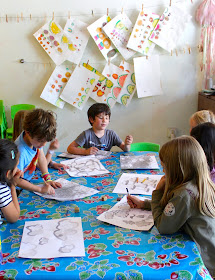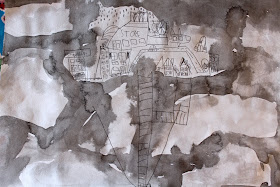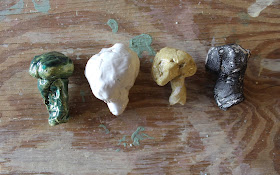Quite a few people have asked me about creating this accordion book with kids so I looked through my images and found quite a few of for this drawing project so I here it goes This accordion book focuses on creating depth in a painting using just a few materials.
Materials:
cardboard-6 1/2 inches X 6 1/2 inches
watercolor paper- 6 1/2 inches X 24 inches
sumi ink-
brush-
I do pre-fold the watercolor paper for the kids before giving them to the kids and prepare the ink ahead of time but diluting some sumi ink 1 part ink to 4 parts water. The long piece of paper does lend itself to telling a story. We offer the children the idea of a forest as the scene for their narratives. . We talk about You could set it in a city or underwater or the desert. I like to read the kids a story before hand to offer a little inspiration, linking ideas and language with their drawings. I read them the "The Deep Dark Woods".
The kids started with the watered down ink and we talked about all the different shapes of trees. Once that layer dries, I give them the full strength sumi ink. I ask them to add a few trees using the black ink or maybe add some details on the lighter trees.
Does it look like the darker trees are closer than the light trees or farther way?
The scene is all set for their stories. I give them oil pastels to draw the characters in the forest and add details to their trees if they like. The variety of stories and events happening in these forests was so delightful.
I don't have images of their covers but we glued the cardboard to each end of the paper, decorated the covers using tape and stickers and colorful paper. We then added a paper handle on each side so that the book could be opened and closed like an accordion.




















































